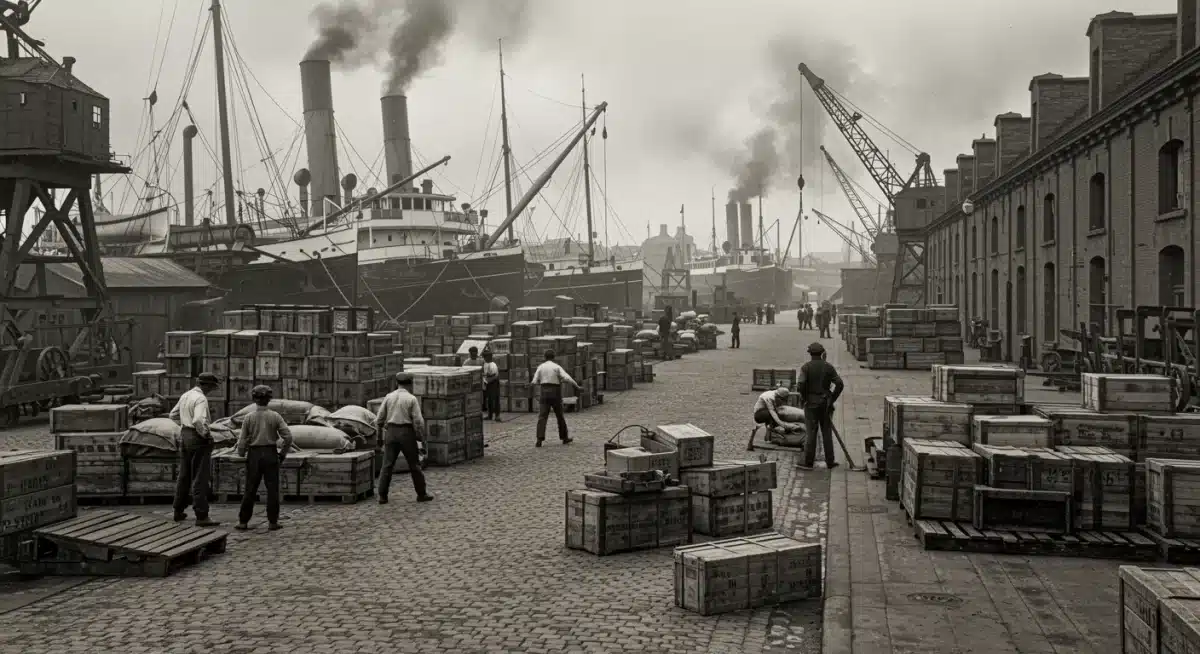Tracing Roots: Supply Chain Vulnerabilities & 20th Century Disruptions

As global events continue to highlight the fragility of our interconnected world, understanding the historical context of supply chain vulnerabilities becomes paramount. This deep dive explores how disruptions from the early 20th century laid foundational lessons still relevant for today’s complex logistical networks, offering practical solutions.
The Genesis of Global Interdependence
The early 20th century marked a pivotal era in global trade, characterized by burgeoning industrialization and expanding colonial empires. This period saw the rapid development of complex supply chains, albeit less sophisticated than today’s, which were nonetheless susceptible to a range of disruptions. These nascent networks, connecting raw material sources to manufacturing hubs and consumer markets, began to reveal inherent weaknesses that would foreshadow future challenges.
The reliance on specific trade routes and limited transportation technologies meant that any significant shock could ripple through the entire system. Early vulnerabilities included:
- Geographic Concentration: Key resources often originated from a few specific regions, creating single points of failure.
- Limited Redundancy: Alternative suppliers or routes were scarce, making systems inflexible.
- Rudimentary Communication: Information flow was slow, hindering rapid response to disruptions.
These foundational issues, while rooted in the technology and political landscape of the time, provide crucial insights into the persistent nature of supply chain fragility.
World War I: A Catalyst for Disruption Awareness
The outbreak of World War I in 1914 served as an unprecedented stress test for global supply chains. The conflict instantly severed established trade routes, reconfigured manufacturing priorities, and highlighted the critical role of logistics in national survival. Nations quickly learned the brutal realities of relying on external sources for essential goods and raw materials.
Naval Blockades and Resource Scarcity
Naval blockades, particularly by the British against Germany, choked off access to vital resources like food, nitrates, and raw materials. This forced nations to innovate rapidly, developing synthetic alternatives or exploiting domestic reserves. The war’s demands led to a significant shift from peacetime production to wartime industries, causing severe shortages in consumer goods and agricultural products across the globe.
The immediate impact was profound:
- Food rationing became commonplace in many European countries.
- Industries pivoted to produce munitions and military equipment.
- New trade alliances and clandestine routes emerged to circumvent blockades.
This period underscored how geopolitical tensions could instantly transform global commerce, creating urgent demands for self-sufficiency and resilient supply networks.
The Roaring Twenties and Economic Volatility
Following the Great War, the 1920s brought a period of economic expansion and increased global trade, but also introduced new forms of supply chain instability. Rapid industrial growth and speculative financial markets created an environment where demand could surge or collapse dramatically, exposing different facets of supply chain vulnerability. While not characterized by wartime blockades, this era presented challenges rooted in economic cycles and market dynamics.
The post-war reconstruction efforts fueled demand for raw materials and manufactured goods, leading to overproduction in some sectors. This boom-and-bust cycle often left producers with excess inventory or facing sudden drops in orders. The lack of robust demand forecasting and inventory management systems meant that businesses were often caught off guard by market shifts. This period highlighted the need for more sophisticated planning and risk assessment beyond just physical disruptions.
The Great Depression: Systemic Collapse and Lessons Learned
The stock market crash of 1929 and the subsequent Great Depression unleashed an unparalleled economic crisis that had devastating effects on global supply chains. Unlike the targeted disruptions of war, the Depression represented a systemic failure of demand, credit, and international trade, revealing fundamental weaknesses in the capitalist system itself. This era teaches invaluable lessons about the interconnectedness of economic health and supply chain stability.
As economies contracted, consumer purchasing power evaporated, leading to massive reductions in production and widespread unemployment. Factories idled, and international trade plummeted as countries implemented protectionist policies. The collapse of financial institutions further exacerbated the crisis, making it difficult for businesses to secure credit for operations or expansion. The global nature of the crisis demonstrated that a localized economic downturn could rapidly spread, causing a domino effect across supply chains worldwide.
Key takeaways from this period include:
- The critical importance of stable financial systems for trade.
- The danger of protectionist policies in a globally integrated economy.
- The need for demand-driven supply chain planning to avoid overproduction.
These insights remain highly relevant in discussions about economic resilience and global trade policies today.

Interwar Period: Geopolitical Tensions and Strategic Resources
The period between World War I and World War II was characterized by simmering geopolitical tensions, rising nationalism, and an arms race that profoundly influenced supply chain strategies. Nations began to prioritize self-sufficiency in strategic resources, learning from the lessons of the previous conflict. This era saw the deliberate stockpiling of critical materials and the development of domestic industries to reduce reliance on potentially hostile foreign suppliers.
Resource Nationalism and Autarky
Many countries pursued policies of autarky, aiming for economic independence, especially in raw materials vital for military production. This led to a fragmentation of global trade and the establishment of closed economic blocs. For instance, Japan’s expansionist policies in Asia were partly driven by the need to secure access to oil, rubber, and other resources. Germany, under the Nazi regime, also focused heavily on synthetic fuels and domestic raw material exploitation to prepare for war.
This focus created:
- Diversification of domestic production, sometimes at higher costs.
- Increased state control over key industries and resources.
- Heightened tensions as nations competed for diminishing global supplies.
The interwar period showed how political ideology and the threat of conflict could fundamentally reshape global supply chains, prioritizing national security over economic efficiency.
World War II and the Birth of Modern Logistics
World War II escalated the challenges faced during the first global conflict, pushing the boundaries of logistics and supply chain management to unprecedented levels. The sheer scale of the conflict, spanning multiple continents and demanding vast quantities of equipment, fuel, and food, forced belligerent nations to develop highly sophisticated and resilient supply systems. This period laid the groundwork for many modern logistical practices and exposed vulnerabilities that still resonate today regarding supply chain vulnerabilities.
Innovation in Supply Chain Management
The war necessitated rapid innovation in transportation, inventory management, and strategic sourcing. The development of new shipping routes, the protection of convoys against submarine attacks, and the mass production of standardized components were crucial for maintaining the war effort. The Allies, in particular, demonstrated remarkable organizational prowess in managing complex global supply lines, from the ‘Red Ball Express’ in Europe to the vast logistical operations in the Pacific. This era solidified the understanding that an efficient and robust supply chain is a strategic asset, essential for national security and economic stability.
Lessons from WWII include:
- The vital role of redundancy and alternative routes.
- Importance of standardized parts for repair and maintenance.
- The need for agile and adaptable logistical command structures.
- Strategic stockpiling of critical materials.
These wartime innovations and the recognition of persistent supply chain vulnerabilities continue to inform contemporary strategies for risk mitigation and resilience building.
Practical Solutions from Historical Insights Today
The historical disruptions of the early 20th century offer invaluable lessons for addressing modern supply chain vulnerabilities. By analyzing past failures and successes, current businesses and governments can implement practical solutions to build more resilient and adaptable supply chains. The core principles remain consistent: diversification, transparency, and strategic planning are key to navigating an unpredictable global landscape.
Building Resilience in Modern Supply Chains
Drawing from the past, several practical steps can be taken:
- Diversify Sourcing: Reduce reliance on single suppliers or geographic regions, echoing the lessons from wartime blockades and resource nationalism.
- Enhance Visibility: Implement advanced tracking and data analytics to gain real-time insights into supply chain operations, addressing the communication gaps of earlier eras.
- Strategic Stockpiling: Maintain reserves of critical components and raw materials, similar to interwar strategies, to buffer against sudden disruptions.
- Foster Collaboration: Strengthen relationships with suppliers and logistics partners to create more integrated and responsive networks.
- Scenario Planning: Regularly conduct risk assessments and develop contingency plans for various disruption scenarios, from geopolitical conflicts to economic downturns.
These proactive measures, rooted in historical experiences, are essential for mitigating the impact of future disruptions and ensuring the continuity of global commerce. Understanding the historical context of supply chain vulnerabilities is not merely an academic exercise; it’s a blueprint for future resilience.
| Key Point | Brief Description |
|---|---|
| WWI Impact | Wartime blockades and resource reallocation exposed critical vulnerabilities in nascent global supply chains. |
| Great Depression | Systemic economic collapse highlighted vulnerabilities tied to demand, credit, and trade protectionism. |
| WWII Logistics | Necessitated advanced logistics and strategic sourcing, forming the basis for modern supply chain practices. |
| Modern Solutions | Diversification, visibility, and strategic stockpiling are key solutions derived from historical insights. |
Frequently Asked Questions About Supply Chain Vulnerabilities
World War I immediately revealed critical supply chain vulnerabilities through naval blockades, which cut off essential resources, and the rapid shift to wartime production, causing widespread shortages. This forced nations to realize their over-reliance on specific trade routes and foreign suppliers, highlighting the need for domestic alternatives and strategic resource management.
The Great Depression demonstrated that systemic economic downturns, characterized by collapsed demand and credit, could devastate global supply chains. It underscored the importance of stable financial systems, the dangers of protectionism, and the need for demand-driven planning to prevent overproduction and ensure economic resilience across interconnected markets.
World War II spurred unprecedented advancements in logistics, including new transportation methods, standardized components, and strategic resource allocation. The sheer scale of wartime demands necessitated highly efficient and adaptable supply systems, laying the groundwork for many contemporary supply chain practices focused on resilience, redundancy, and agile command structures.
Practical solutions include diversifying sourcing to avoid single points of failure, enhancing supply chain visibility through data analytics, strategic stockpiling of critical materials, fostering strong supplier collaborations, and implementing robust scenario planning. These measures directly address historical weaknesses identified in early 20th-century disruptions, creating more resilient networks.
Understanding historical disruptions is crucial because many foundational vulnerabilities, such as over-reliance on single sources or lack of transparency, persist. History offers a blueprint for identifying recurring patterns of fragility and provides proven strategies for building resilience against modern challenges, from geopolitical conflicts to economic instability and natural disasters.
Looking Ahead
The ongoing global landscape, marked by geopolitical shifts, technological advancements, and climate change, continues to test the robustness of modern supply chains. The insights gleaned from early 20th-century disruptions are not merely historical footnotes but serve as urgent reminders for proactive engagement. Businesses and governments must continuously adapt, integrate historical lessons, and invest in resilient strategies to navigate future complexities, ensuring the stability of global commerce and essential goods flow.





